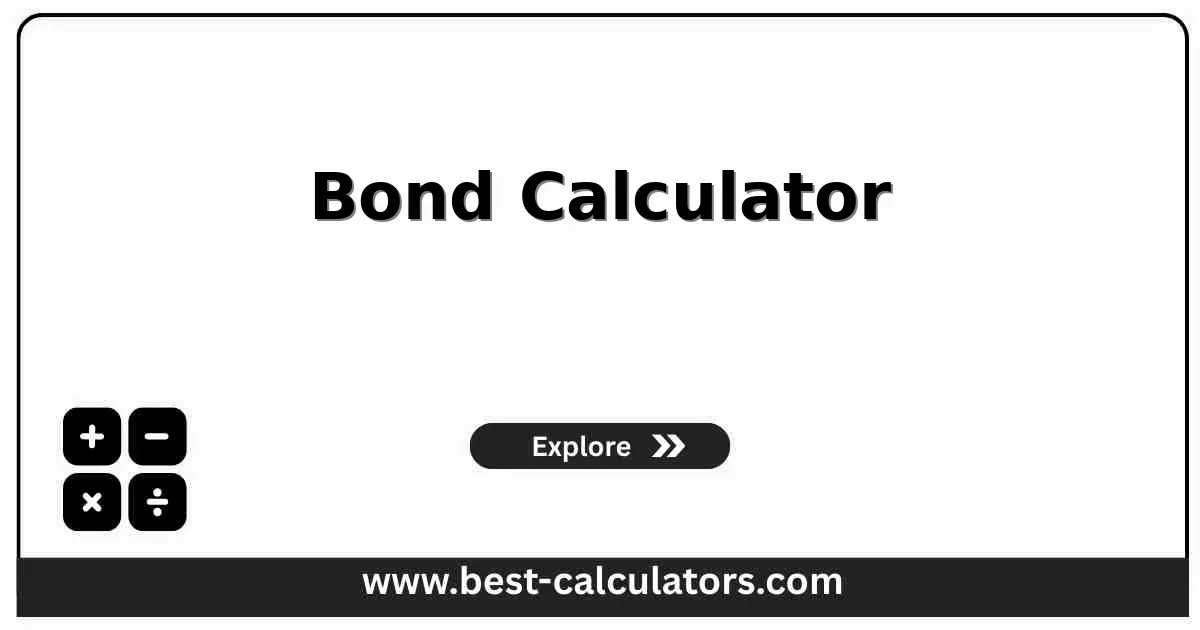Bond Calculator - Calculate Bond Yields & Returns
Free bond calculator to determine current yield and yield to maturity with coupon payment analysis and premium/discount valuation
Bond Calculator
Results
What is a Bond Calculator?
A Bond Calculator is a free financial tool that helps you evaluate bond investments by calculating key yield metrics and total returns. It determines the current yield, yield to maturity (YTM), coupon payments, and whether you're paying a premium or discount.
This calculator is essential for:
- Bond Investment Analysis - Evaluate corporate, municipal, and government bonds
- Yield Comparison - Compare different bonds to find the best returns
- Portfolio Planning - Assess income generation and capital appreciation potential
- Risk Assessment - Understand bond pricing relative to face value and market conditions
Investment Calculator - Project total returns on various investment types
ROI Calculator - Calculate return on investment for any asset
Compound Interest Calculator - Calculate exponential growth on reinvested earnings
Retirement Calculator - Plan retirement portfolio with bonds and fixed income
Present Value Calculator - Compare certificates of deposit vs bond investments
How the Bond Calculator Works
The calculator uses proven bond valuation formulas:
Current Yield:
CY = (Annual Coupon / Current Price) × 100
Yield to Maturity (Approximate):
YTM ≈ [C + (F - P) / Y] / [(F + P) / 2] × 100
Where:
- C = Annual coupon payment
- F = Face value (par value)
- P = Current market price
- Y = Years to maturity
The calculator also computes total coupon payments (Annual Coupon × Years), total return (Face Value + Total Coupons - Purchase Price), and premium/discount (Price - Face Value).
Key Bond Concepts
Face Value
The par value paid at maturity, typically $1,000 for corporate bonds. This is the amount the issuer repays when the bond matures.
Coupon Rate
The annual interest rate paid on the bond's face value. A 5% coupon on a $1,000 bond pays $50 per year.
Current Yield
Annual coupon income divided by current market price. Shows the immediate income return from the bond investment.
Yield to Maturity
Total return if held to maturity, including all coupon payments and any capital gain or loss from purchase price to face value.
Premium Bond
Trading above face value (price > $1,000). Occurs when coupon rate exceeds current market rates for similar bonds.
Discount Bond
Trading below face value (price < $1,000). Occurs when coupon rate is lower than current market rates for similar bonds.
How to Use This Calculator
Enter Face Value
Input the par value of the bond, typically $1,000 for most bonds
Enter Coupon Rate
Input the annual interest rate (e.g., 5% for a 5% coupon bond)
Set Years to Maturity
Specify how many years until the bond matures (e.g., 10 years)
Enter Market Price
Input the current trading price (e.g., $950 for a discount bond)
Select Payment Frequency
Choose annual or semi-annual coupon payment schedule
View Results
See yields, total returns, and premium/discount analysis
Benefits of Using This Calculator
- • Accurate Yield Analysis: Calculate both current yield and yield to maturity for comprehensive bond evaluation.
- • Compare Bond Investments: Evaluate multiple bonds to find the best risk-adjusted returns for your portfolio.
- • Understand Pricing: See exactly how much premium or discount you're paying relative to face value.
- • Plan Income Streams: Calculate exact coupon payments to plan your fixed-income cash flow.
- • Total Return Projection: See your complete return including all coupons and capital gains/losses.
- • Investment Decisions: Make informed choices about which bonds align with your financial goals.
Factors That Affect Bond Yields
1. Interest Rate Environment
When market rates rise, existing bonds with lower coupons trade at discounts, increasing YTM. When rates fall, bonds with higher coupons trade at premiums, decreasing YTM.
2. Time to Maturity
Longer-term bonds are more sensitive to interest rate changes. The premium or discount narrows as the bond approaches maturity and converges to face value.
3. Credit Quality
Higher-rated bonds (AAA) typically offer lower yields due to lower risk. Lower-rated bonds must offer higher yields to compensate for increased default risk.
4. Payment Frequency
Semi-annual payments provide more frequent cash flow and allow for reinvestment. The payment schedule affects the timing of returns but not the stated coupon rate.

Frequently Asked Questions (FAQ)
Q: What is the difference between current yield and yield to maturity?
A: Current yield is the annual coupon payment divided by the current market price, showing immediate income return. Yield to maturity (YTM) accounts for all future coupon payments plus any gain or loss from the difference between purchase price and face value at maturity.
Q: What does it mean when a bond trades at a premium or discount?
A: A bond trades at a premium when its market price is above face value (you pay more than par). It trades at a discount when the price is below face value (you pay less than par). Premium bonds typically have higher coupon rates than current market rates.
Q: How does payment frequency affect bond returns?
A: Semi-annual payments (most common for bonds) provide more frequent cash flow and slight compounding benefits compared to annual payments. The frequency affects how often you receive coupon payments but doesn't change the stated coupon rate.
Q: Should I buy bonds trading at a discount or premium?
A: It depends on your goals. Discount bonds offer capital appreciation potential as they approach face value at maturity. Premium bonds provide higher current income but will decline to face value. Compare the yield to maturity to determine true value regardless of premium or discount.